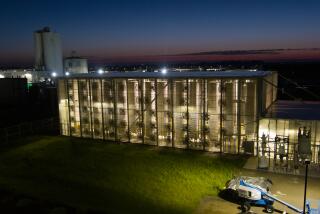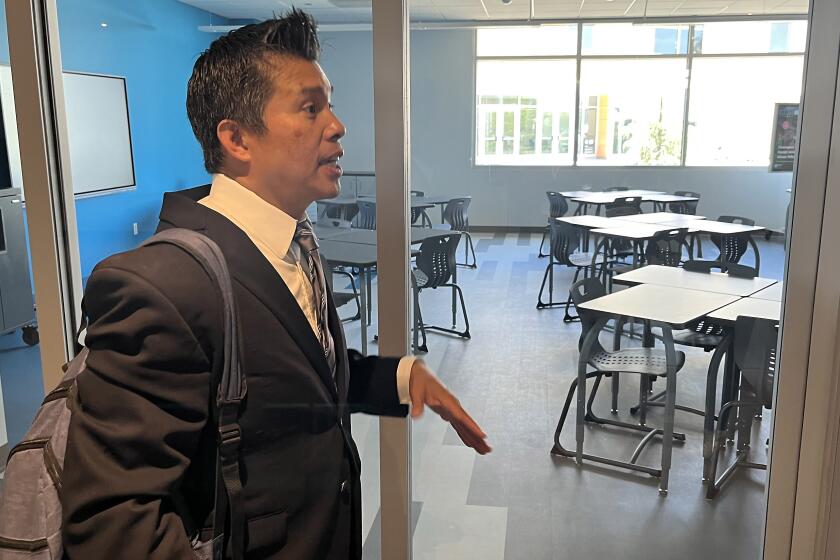Geothermal power industry lost steam but may be poised for comeback

- Share via
MIDDLETOWN, Calif. — — Geothermal power was once king of California’s renewable energy. So many companies were clamoring to transform steam into electricity that they sucked the world’s largest geyser field dry.
But the industry’s shortsightedness — and its slowness to innovate — left geothermal floundering for three decades in the shadows of the solar and wind energy juggernauts. Now, industry leaders say the energy harnessed from the Earth is poised for a renaissance, powered by new technology that will boost production, pare costs and expand its reach.
“We had been in a gradual decline, but we’ve turned the corner,” said Doug Hollett, director of the federal Energy Department’s Geothermal Technologies Office. “The growth curve for geothermal is extremely exciting.”
Some impetus for the change has come from within. The geothermal industry’s not-so-politically-savvy leaders, mostly geologists and mechanical engineers, had since the 1980s been eclipsed by hard-charging solar and wind energy developers who play the lobbying game, and play it well.
Geothermal’s leaders watched and learned. Their challenge now, they say, is regaining some of the lost political and financial ground.
“We thought our competitors were fossil fuels,” said Bob Sullivan, senior vice president of Ormat Technologies Inc., the nation’s largest geothermal developer. “Now we’re finding that our competitors are other renewable technologies.”
Although geothermal companies are unlikely to be the energy giants that solar and wind producers have become, new technology could enable the industry to grow far beyond the Western states.
Geothermal heyday
Pacific Gas & Electric completed the nation’s first commercial geothermal power plant at the Geysers in 1960. Wells driven 12,000 feet into the ground tapped into magma and swirling steam that was piped to the surface to drive turbines.
The vast energy trove in the Mayacamas Mountains north of San Francisco produced clean, seemingly limitless power at a time when Americans’ appetite for energy was growing insatiable.
“Back in the day, we were the only game in town,” said Joseph Ronan Jr., senior advisor at Calpine Corp., which owns most of the geothermal plants at the Geysers.
But the industry’s lack of discipline became its undoing. By the mid-1980s, more than 20 energy companies crowded into the 45-square-mile field, pumping out steam with abandon. In the frenzy to harvest cheap energy, too many companies drew too much water from underground reservoirs.
By 1987, steam production was in rapid decline and electric generation from the Geysers plummeted to almost nothing.
Now, geothermal energy accounts for barely 0.4% of the nation’s available energy.
Solar energy has emerged as “the darling child” of federal agencies that fund energy research and development, Sullivan said. Its leaders come from the politically connected ranks of the oil and gas business, and they used their savvy to tap into federal and state incentives, ranging from tax credits to loan guarantees.
Among renewable energy industries receiving research funding from the U.S. Energy Department, geothermal is solidly at the bottom. The agency’s 2014 research budget for geothermal is $45 million, compared with $257 million for solar.
The project approval process at federal agencies also works faster for solar projects. The U.S. Bureau of Land Management estimates the average wind or solar project is greenlighted in 1 1/2 years. Approval for a geothermal project can take as long as seven years.
“We often do feel like the stepchild of renewables,” said Karl Gawell, executive director of the Geothermal Energy Assn.
What helps propel the solar industry is that it is selling a lifestyle, Gawell said, noting that environmental groups have mounted well-funded campaigns that extol solar power as a response to the threat of climate change.
“I tell my staff all the time, ‘Watch solar and learn from what they do,’” Gawell said.
Bill Richardson, President Clinton’s energy secretary and a fan of geothermal energy, called the technology “unsexy” compared to solar energy.
“They should hustle a little bit more,” he said of geothermal executives.
Breaking Through
While geothermal industry leaders take notes on the political front, researchers are investigating ways to overcome technological barriers.
The Energy Department is funding research into recycling unwanted hot water that is exhumed during drilling in the nation’s expanding oil fields. Reclaimed superheated water — nine gallons of it for every gallon of oil — would be used to turn turbines that harness geothermal energy in small plants right in the oil and gas fields.
Researchers are also experimenting with an Enhanced Geothermal System, a technique that could unlock geothermal energy across the country.
Traditionally, geothermal prospecting takes place only where steam, made by hot rocks and water, naturally occurs. It’s a phenomenon largely found in California, Nevada and Utah. The EGS technique would enable companies to generate energy wherever molten rocks exist by injecting water into the ground to create steam that fuels turbines.
These technological advances almost didn’t get funded, though. The Energy Department mulled closing its geothermal office in 2006, convinced that technology had taken the industry as far as it could.
That year, a Massachusetts Institute of Technology report predicted a bright future for geothermal. It chided the government for failing to invest research and development money and concluded that geothermal energy’s value was underestimated.
“In spite of its enormous potential, the geothermal option for the United States has been largely ignored,” the report found.
Geothermal will never be a major energy source, the MIT report concluded, but if fully tapped, it could provide as much as 10% of the nation’s power.
The technology is already making a difference in California, where geothermal power plants generated more than 32% of California’s total renewable energy last year, nearly three times more than solar.
Geothermal rebound
The Geysers steam field, once sapped by overpumping, is now replenished by a daily injection of 20 million gallons of treated wastewater that officials in the city of Santa Rosa and Lake County couldn’t find an economical way to dispose of. It’s the first project of its kind in the world.
On the other end of the state from the Geysers, geothermal company EnergySource has teamed up with chemical processing firm Simbol Materials to develop another promising opportunity.
Two great tectonic plates at the Salton Sea have been pulling apart for eons, stretching the Earth’s crust and creating a deep rift valley. Superheated magma is closer to the surface, and awash with a mineral-rich brine that has been simmering for millions of years. Geothermal plants there tap into water as hot as 450 degrees and readily convert it to steam.
But the brine is caustic and clogged with minerals. As it cools, the minerals form a hard, glassy substance that coats the inside of a plant’s pipes, gradually narrowing its arteries and limiting efficiency. The expense of cleaning or replacing that equipment has made producing energy cost-prohibitive.
Simbol, a former mining company, has helped solve the problem. It extracts valuable minerals from the brine and then pumps the water back into EnergySource’s geothermal plant next door.
EnergySource keeps its pipes clean and produces steam energy. Simbol gets to sell the minerals and can run its plant on electricity that EnergySource produces.
Simbol’s chief executive, John Burba, said the company’s process is yielding lithium, a highly sought-after mineral that’s now powering research into advanced batteries. The firm is poised to piggyback its plant with other geothermal facilities in the region.
“For decades people have talked about mineral recovery from the Salton Sea,” said Gawell of the Geothermal Energy Assn. “There are something like 30 strategic minerals that flow through power plants right now. It would be the Holy Grail of mining to be able to produce all of that from a geothermal well.”
Industry executives and Imperial County officials say the breakthrough could be the driver that helps rejuvenate the deteriorating lake.
With some luck, it could provide momentum for the geothermal industry’s comeback.
Twitter: @julie_cart
More to Read
Sign up for Essential California
The most important California stories and recommendations in your inbox every morning.
You may occasionally receive promotional content from the Los Angeles Times.














